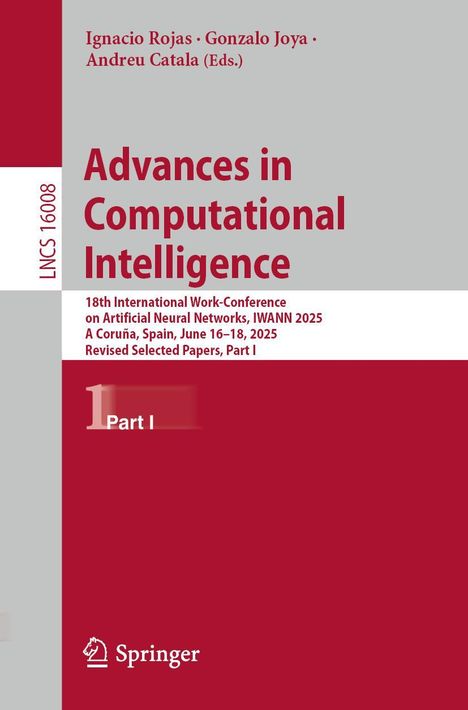Advances in Computational Intelligence, Kartoniert / Broschiert
Advances in Computational Intelligence
- 18th International Work-Conference on Artificial Neural Networks, IWANN 2025, A Coruña, Spain, June 16-18, 2025, Proceedings, Part I
(soweit verfügbar beim Lieferanten)
- Herausgeber:
- Ignacio Rojas, Gonzalo Joya, Andreu Catala
- Verlag:
- Springer, 10/2025
- Einband:
- Kartoniert / Broschiert
- Sprache:
- Englisch
- ISBN-13:
- 9783032027245
- Artikelnummer:
- 12358662
- Umfang:
- 700 Seiten
- Gewicht:
- 1042 g
- Maße:
- 235 x 155 mm
- Stärke:
- 38 mm
- Erscheinungstermin:
- 2.10.2025
- Hinweis
-
Achtung: Artikel ist nicht in deutscher Sprache!
Weitere Ausgaben von Advances in Computational Intelligence |
Preis |
|---|---|
| Buch, Kartoniert / Broschiert, Englisch | EUR 164,28* |
Klappentext
.- Advanced Topics in Computational Intelligence.
.- Power Quality 24-hour Prediction Based on L-Transform Derivative Modular and Deep Learning Statistics Using Environmental Data in detached Smart Buildings.
.- Incremental Feature Learning of Shallow Feedforward Regression Neural Networks using Particle Swarm Optimisation.
.- Resilience Under Attack: Benchmarking Optimizers Against Poisoning in Federated Learning for Image Classification Using CNN.
.- VIDEM: VIDeo Effectiveness and Memorability Dataset.
.- Penetration Testing with AI: Case Studies on LLM and RL-Based Attack Agents.
.- A comparative study of deep learning approaches for classifying wild and cultivated fish.
.- Sparse Least Square SVM in Primal via Nesterov Accelerated Alternating Directions Method of Multipliers.
.- AI: Bioinformatics and Biomedical Applications.
.- A transformer-based model to predict micro RNA interactions.
.- Leveraging Large Language Models on Assay Descriptions to Improve the Prediction of Inhibitors for Mycobacterium tuberculosis.
.- Advancing Imminent Fracture Risk Prediction: Integrating Machine Learning with Enhanced Feature Engineering.
.- Self-organizing Maps for Missing Value Imputation in Transcriptomic Datasets.
.- ANN HW-Accelerators.
.- RECS: A Scalable Platform for Heterogeneous AI Acceleration in the Cloud-Edge Continuum.
.- Evaluating HBM to accelerate neural networks on FPGAs demonstrated using binary neural associative memories.
.- Resource-efficient Implementation of Convolutional Neural Networks on FPGAs with STANN.
.- High-Performance FPGA-based CNN Acceleration for Real-Time DC Arc Fault Detection.
.- Optimizing AI on the Edge: Partitioning Neural Networks Across Heterogeneous Accelerators.
.- Comparison of Hardware Component and Manycore Implementation for Anomaly Detection in Trustworthy System-on-Chips.
.- Bio-Inspired Systems and Neuro-Engineering.
.- An Emotional Classifier for Machine's Artificial Visual Aesthetic Appraisal.
.- Hardware and Software influence on EAs power consumption.
.- Properties of monoclinic gallium oxide film and its photomemristor application in nonlinear RMC circuit.
.- A perceptron-like neural network implementing a learning-capable K-nearest neighbor classifier.
.- From Biological Neurons to Artificial Neural Networks: A Bioinspired Training Alternative.
.- Recent Advances in Deep Learning.
.- Domain Adaptation of the Whisper ASR Model for Tourism Call Center Transcription in Polish.
.- Learning to Search with Subgoals.
.- Towards Speaker Independent Speech Emotion Recognition by means of Dataset Aggregation.
.- Learning Heuristics for k-NANN-A*: A Deep Learning Approach.
.- Evaluating Higher-Level and Symbolic Features in Deep Learning on Time Series: Towards Simpler Explainability.
.- Energy-Efficient Radio Resource Allocation in 5G Using Deep Q-Networks.
.- Multi-view Cross Contrastive Learning for Multimodal Knowledge Graph Recommendation.
.- MuleTrack: A Lightweight Temporal Learning Framework for Money Mule Detection in Digital Payments.
.- Modular Deep Neural Networks with residual connections for predicting the pathogenicity of genetic variants in non coding genomic regions.
.- Modeling Student--Subject Interactions with GNNs for Grade Prediction.
.- Deploying Vision Foundation AI Models on the Edge. The SAM2 Experience.
.- Generative AI for Contextualizing Bronze Age Objects in Historical Scenes.
.- G-TED SAM: Node Classification via Graph Transformer to Simple Attention Model Distillation.
.- Expression Recognition in Faces Partially Occluded by Head-Mounted Displays.
.- Reinforcement Learning for Mapless Navigation: Enhancing Exploration with Image-Based Rewards


